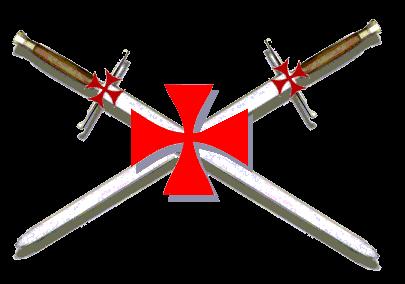from Encyclopedia J-K pg 353
 Knights Templars were members of a religious military order of Christian Knighthood.
The order was founded about 1119 in Jerusalem by the French knights Hugh des Payens
and Godfrey of St. Omar. The order was first called "The poor Fellow-Soldiers of Christ and
the Temple of Solomon" because of their early state of poverty and the lodgings given to
them by King Baldwin ll of Jerusalem. The lodgings were in the compound of the King's palace
known as the Temple of Solomon.
Knights Templars were members of a religious military order of Christian Knighthood.
The order was founded about 1119 in Jerusalem by the French knights Hugh des Payens
and Godfrey of St. Omar. The order was first called "The poor Fellow-Soldiers of Christ and
the Temple of Solomon" because of their early state of poverty and the lodgings given to
them by King Baldwin ll of Jerusalem. The lodgings were in the compound of the King's palace
known as the Temple of Solomon.
The original purpose of the Templars complemented that of the Knights of St. John of Jerusalem, also known as the Knights Hospitaller. This latter order aided pilgrims in the Holy Land while
the Templars protected pilgrims on the way to and from the Holy Land.
The Templars organized under a rule composed by Saint Bernard of Clairvaux. he stimulated
the order's fame and growth through his writings and preaching during the Second Crusade. The Templars took monastic vows of poverty, chastity, and obedience. They avoided extravagant ceremony and clothing, wearing the white mantle of the Cistercian order, with a red cross added.
At first the order included only knights, but gradually it admitted chaplains - priests who
ministered to the knights - and sergeants - wealthy members of the middle class. The pope took the knights under his special protection, and the order added to its original purpose the duty to fight all "infidels" who threatened Christianity. The Templars thus played a key role in the Crusades and became a powerful military organization. The order grew rich with properties donated by grateful kings and princes.
The Templars entered the banking business, and Temples (local lodges) established throughout
Europe attracted deposits of massive wealth. Princes and commoners alike banked with the Templars, and many states became indebted to them. With the fall of the Holy Land to the Muslims in 1187, the order lost its founding purpose and became a target for unhappy and envious debtors.
In 1302, king Philip lV of France came into conflict with the pope. The king was also near bankruptcy. He waged a vicious and skillful campaign aimed at suppressing the Templars, hoping to gain the order's wealth at the same time to strike a blow against the papacy. Philip ordered all the Templars in France thrown in prison, where they were tortured until they confessed to accusations of heresy, unnatural practices, and dishonest business activities. Historical evidence has supported only the charge of dishonesty.
Templars in England, Germany, Spain, and Portugal also stood trail, but most were acquitted because they were beyond Philip's immediate control. in 1312, pope Celment V yielded to Philip's pressure and issued a bull (official degree) suppressing the Templars. The pope, however, awarded the Templar's property to several military orders in Spain and Portugal and its cash holdings to the Knights Hospitaller. During the French trails, the Templars' last grand master, Jacques de Molay, confessed to false charges. He later withdrew the confession but was burned at the stake anyway in 1314.

